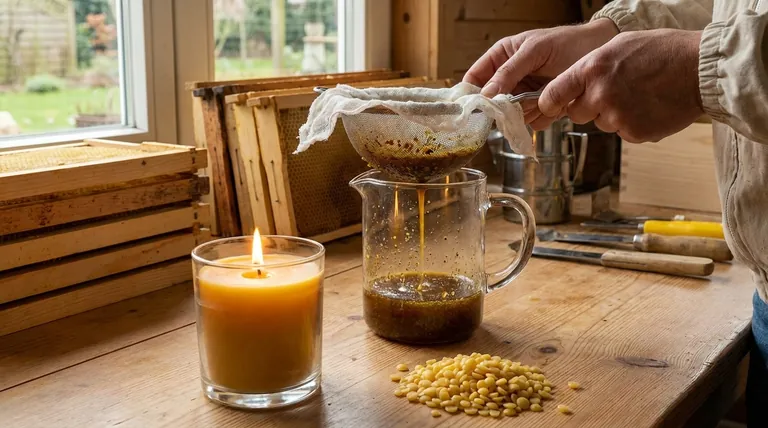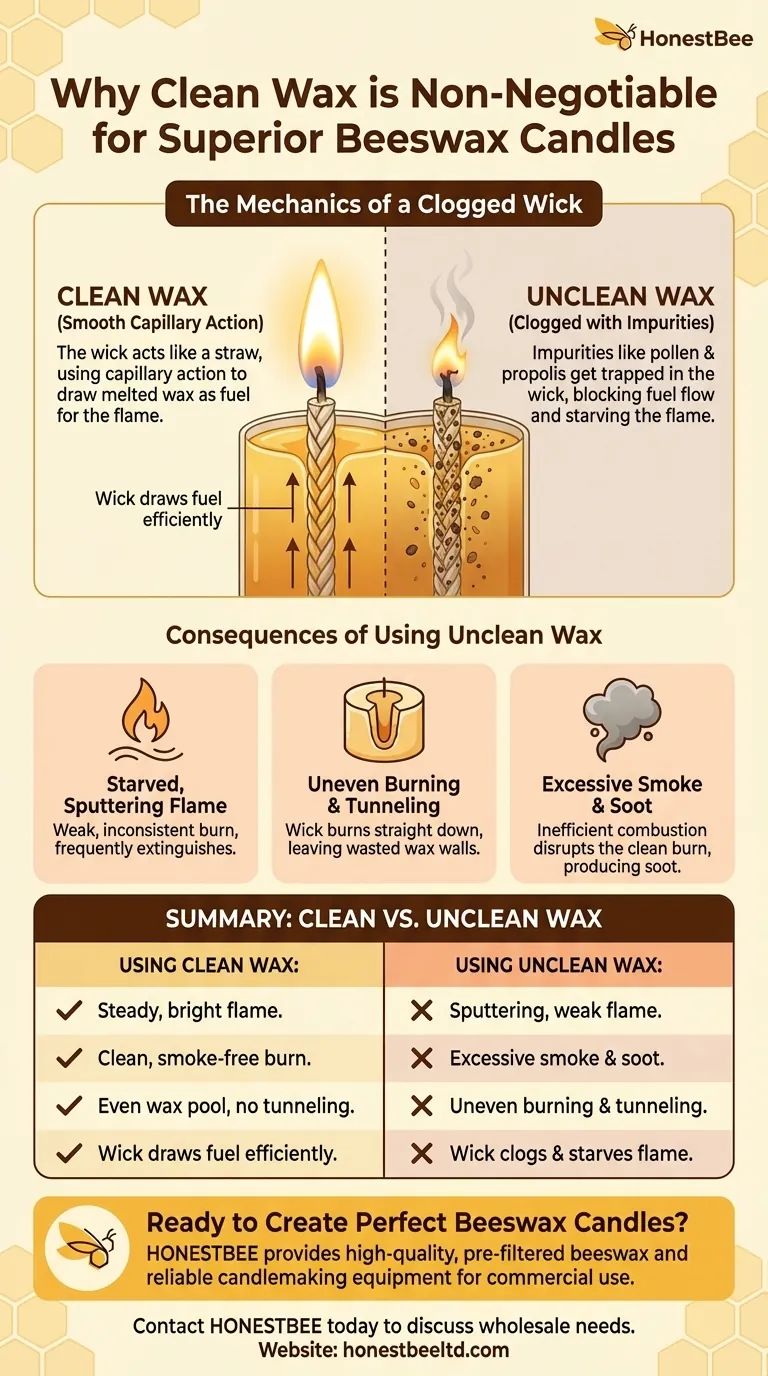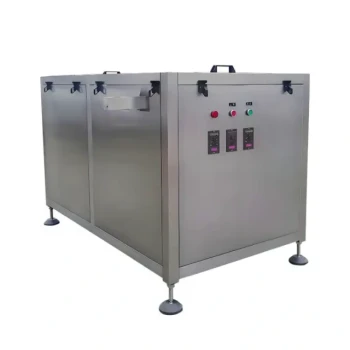To put it simply, clean beeswax is essential because any impurities—like dust, pollen, or propolis—will inevitably clog the candle's wick. This blockage prevents the wick from drawing up melted wax, effectively starving the flame of fuel. The result is a candle that sputters, burns unevenly, produces smoke, or extinguishes itself entirely.
The performance of a beeswax candle depends entirely on the wick's ability to consistently draw fuel to the flame. Using wax that has not been properly cleaned is the single most common reason for candle failure, as it physically obstructs this critical process.

The Mechanics of a Clogged Wick
To understand why clean wax is non-negotiable, you first have to understand how a candle actually works. It's a simple but delicate system.
How a Wick Functions
A candle wick works through capillary action. Think of it as a straw for liquid wax. The porous fibers of the wick draw the hot, melted wax up from the pool at the base of the flame, delivering it as fuel to be combusted.
This process must be continuous and uninterrupted for the candle to burn steadily and brightly.
The Problem with Impurities
Raw beeswax straight from the hive contains more than just wax. It includes microscopic debris such as pollen, propolis (a resinous bee glue), and other hive particles.
While these are natural, they are not combustible. They are tiny solids suspended in the liquid wax.
Why Clogging Occurs
As the wick draws up the melted wax, it also draws up these solid impurities. The particles become trapped in the wick's braided fibers, creating a physical blockage.
Once clogged, the wick can no longer effectively transport fuel to the flame. The candle's performance rapidly deteriorates.
Consequences of Using Unclean Wax
Using wax that hasn't been properly filtered leads directly to the problems that candle makers work so hard to avoid. It negates the very reasons for choosing premium beeswax in the first place.
A Starved, Sputtering Flame
The most immediate effect of a clogged wick is a weak and inconsistent flame. The flame shrinks and sputters because its fuel supply is being choked off. In many cases, it will simply extinguish itself.
Uneven Burning and Tunneling
A small, weak flame doesn't generate enough heat to melt the entire surface of the candle. This causes "tunneling," where the wick burns straight down the center, leaving a thick wall of unused wax around the edge.
Excessive Smoke and Soot
Beeswax is prized for its clean, smoke-free burn. However, a clogged wick disrupts the ideal combustion ratio. An unstable, starved flame burns inefficiently, producing the exact smoke and soot you sought to avoid.
Common Pitfalls and How to Avoid Them
The quality of your final candle is determined before you ever pour the wax. The source and preparation of your primary material are everything.
Commercially Prepared Wax
For most hobbyists and professionals, the most reliable choice is commercially prepared beeswax. This wax, often sold as pellets, pastilles, or bars from craft suppliers, has already undergone a thorough filtering process to remove impurities. It is ready to use immediately.
Raw Wax from Beekeepers
Using raw wax from a local beekeeper is an excellent way to control the quality and purity of your ingredients. However, this wax must be cleaned and filtered before it can be used for candles. Skipping this step will guarantee disappointment.
Undermining the Benefits of Beeswax
People choose beeswax because it is a natural, non-toxic material that burns longer, brighter, and cleaner than many other waxes. Using dirty wax completely undermines these advantages, resulting in a poor-quality product that performs worse than a standard paraffin candle.
Making the Right Choice for Your Goal
Your approach should be guided by your resources and your desired outcome.
- If your primary focus is convenience and reliability: Purchase commercially processed beeswax pellets or pastilles that are already cleaned and filtered for candlemaking.
- If your primary focus is control over sourcing or you are a beekeeper: Commit to learning the proper methods for melting and filtering your raw wax before ever adding a wick.
Ultimately, the purity of your wax is the foundation for a successful and beautiful beeswax candle.
Summary Table:
| Using Clean Wax | Using Unclean Wax |
|---|---|
| Steady, bright flame | Sputtering, weak flame |
| Clean, smoke-free burn | Excessive smoke and soot |
| Even wax pool, no tunneling | Uneven burning and tunneling |
| Wick draws fuel efficiently | Wick clogs and starves the flame |
Ready to create perfect beeswax candles?
For commercial apiaries and beekeeping equipment distributors, the quality of your supplies is paramount. HONESTBEE provides high-quality, pre-filtered beeswax and reliable candlemaking equipment through our wholesale operations, ensuring your candles burn cleanly and consistently every time.
Contact HONESTBEE today to discuss your wholesale supply needs and elevate your product line.
Visual Guide

Related Products
- Electric Flatting and Embossing Machine with Tray for Beekeeping
- Electric Beeswax Foundation Machine With Operating Tray and Wax Foundation Roller
- Professional Frame Preparation: The HONESTBEE Electric Wire Embedder
- Honey Wax Separating Wax Press with Metal Screw Wax Separator Machine
- Stainless Steel Manual Honey Press with Guard for Pressing Honey and Wax
People Also Ask
- What tools are used to cut wax foundations? The Essential Guide for a Perfect Fit
- What are the primary products of honey bee farming besides honey? Discover the Hive's Hidden Treasures
- What are the main methods of honey extraction? Optimize Your Harvest for Maximum Yield
- What qualities are important for someone starting in beekeeping? Build a Thriving Apiary with the Right Mindset
- What is the importance of soaping the rollers during milling? Prevent Wax Adhesion & Equipment Downtime



















